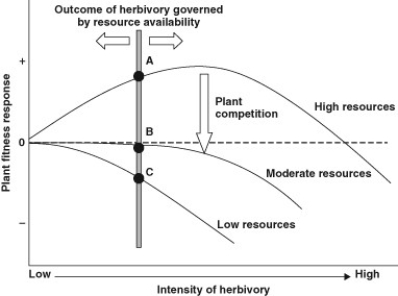Use the figure to answer the following question.
The figure proposes a combination of a top-down and bottom-up model (a hypothesis) to describe the variable effects of biological control herbivores on the fitness (growth and reproduction) of an invasive, non-native plant, spotted knapweed (Centaurea stoebe) . These herbivores include multiple insects that were first studied in the plant's native home range in eastern Europe, where the plant is not dominant in grassland communities and does not pose a problem to land managers and conservationists. Many insects there were found to consume the plant's tissues, including stems, leaves, and seeds, and some were very host specific and were not found to attack plants other than C. stoebe. Several insects were subsequently transported and released in an attempt to reduce densities of this non-native and problematic weed in the United States. The y-axis shows C. stoebe plant fitness, and the x-axis represents the intensity of herbivory by the insects, from low to high. As the vertical shaded bar is moved along the x-axis, the ultimate effect of herbivory (now A, B, andC) on plant fitness can change based on its intensity and also may depend on the other factors. The horizontal dashed line represents no predicted change in fitness under the effects of varying intensity of herbivory, plant competition, and soil resources available to the plant (such as nitrogen or water) , while the three solid lines represent other possible outcomes.
(D) G. Knochel and T.R. Seastedt. 2011. Reconciling contradictory findings of herbivore impacts on spotted knapweed (Centaurea stoebe) growth and reproduction. Ecological Applications 20(7) :1903-1912.
What portion of the model would be characterized as bottom-up?
A) plant fitness
B) resources available to the plant
C) intensity of herbivory on the plant
D) plant competition and fitness
Correct Answer:
Verified
Q36: Imagine five forest communities, each with one
Q37: Keystone predators can maintain species diversity in
Q38: Use the figures to answer the following
Q39: Which of the following studies would a
Q40: Bouchard and Brooks studied the effect of
Q42: There are more species in tropical areas
Q43: Which of the following studies would shed
Q44: Why do moderate levels of disturbance result
Q46: Use the following diagram of five islands
Q54: Which of the following is a widely
Unlock this Answer For Free Now!
View this answer and more for free by performing one of the following actions

Scan the QR code to install the App and get 2 free unlocks

Unlock quizzes for free by uploading documents